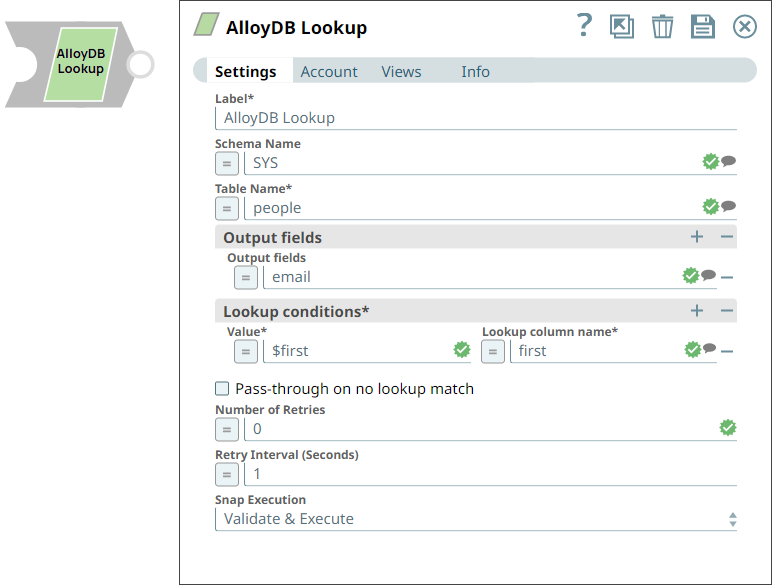AlloyDB Lookup
Overview

Read-type Snap
Works in Ultra Tasks
Behavior changes
- The following are the behavior changes caused by the JDBC driver upgrade for PostgreSQL Snap Pack and Google AlloyDB Snap Pack
- Some error messages will now include the data type for certain values, for example:
-
Old:
"...where (badId = 1) was aborted:..." -
New:
"...where (badId = ('1'::numeric)) was aborted:..."
-
- There are some minor text changes to a few of the error messages, for example:
-
Old:
"Hint: No operator matches the given name and argument types." -
New:
"Hint: No operator matches the given name and argument type(s)."
-
Snap views
| View | Description | Examples of upstream and downstream Snaps |
|---|---|---|
| Input | Each document should have values for one AND clause in the WHERE statement. | |
| Output | This Snap has exactly one document output view. The output document includes
the corresponding input data under the "original" key. If there are no results from
the query, each output field will have a null value. Queries produced by Snap have
the format: |
|
| Error |
Error handling is a generic way to handle errors without losing data or failing the Snap execution. You can handle the errors that the Snap might encounter when running the pipeline by choosing one of the following options from the When errors occur list under the Views tab. The available options are:
Learn more about Error handling in Pipelines. |
|
Snap settings
- Expression icon (
): Allows using pipeline parameters to set field values dynamically (if enabled). SnapLogic Expressions are not supported. If disabled, you can provide a static value.
- SnapGPT (
): Generates SnapLogic Expressions based on natural language using SnapGPT. Learn more.
- Suggestion icon (
): Populates a list of values dynamically based on your Snap configuration. You can select only one attribute at a time using the icon. Type into the field if it supports a comma-separated list of values.
- Upload
 : Uploads files. Learn more.
: Uploads files. Learn more.
| Field / Field set | Type | Description |
|---|---|---|
| Label | String | Required. Specify a unique name for the Snap. Modify this to be more appropriate, especially if more than one of the same Snaps is in the pipeline. Default value: AlloyDB Lookup Example: Check Records |
| Schema name | String/Expression/ Suggestion | Specify the database schema name. Selecting a schema filters the Table
name list to show only those tables in the selected schema. Warning: The values can be passed using the Pipeline parameters but not the
upstream parameter. Default value: N/A Example: SYS |
| Table name | String/Expression/ Suggestion | Required. Specify or select the name of the table to
execute the lookup query on. Note: The values can be passed using the pipeline
parameters but not the upstream parameter. Default value: N/A Example: People |
| Output fields | String/Expression/ Suggestion | Specify or select output field names for an SQL SELECT statement. If this
property is empty, the Snap selects all fields by executing the statement "SELECT *
FROM ...". Default value: N/A Example: email, address, first, last |
| Lookup conditions | Required. The lookup conditions are created by using the lookup column name and the lookup column value. Each row will build a condition, such as lookupColumn1 = $inputField. Each additional row will be concatenated using a logical AND. All rows together build the lookup condition being used to look up records in the lookup table. | |
| Value | String/Expression | Required. Enter or select the JSON path of the lookup
column value. The value will be provided by the input data field. Default value: N/A Example: $email, $first, $last |
| Lookup column name | String/Expression/ Suggestion | Required. Enter or select the lookup column name. Default value: N/A Example: email, first, last |
| Pass-through on no lookup match | Checkbox | When there is no lookup matching an input document, the input document will
pass through to the output view if this property is checked. Otherwise, it will be
written to the error view as an error condition. Default value: False Example: True |
| Number of Retries | Integer/Expression | Specifies the maximum number of attempts to be made to receive a response. The
request is terminated if the attempts do not result in a response. Default value: 0 Example: 3 |
| Retry Interval | Integer/Expression | Specifies the time interval between two successive retry requests. A retry
happens only when the previous attempt resulted in an exception. Default value: 1 Example: 10 |
| Snap execution | Dropdown list |
Choose one of the three modes in
which the Snap executes. Available options are:
Default value: Execute only Example: Validate & Execute |


